
CS920 Series
High-capacity, multi-format color printing
Get high-volume color printing at up to 55 pages per minute (A4/letter)¹ and multi-format output up to SRA3/12x18, plus optional finishing. Thoughtful engineering drives endurance and minimizes interruptions to keep the work moving, from high-capacity replacement toner³ to long-life fusers and developers.
Compare ModelsWell-equipped and ready to work
With a list of standard features as big as the paper it can print, the CS920 series is a high-capacity performer with expanded finishing choices.
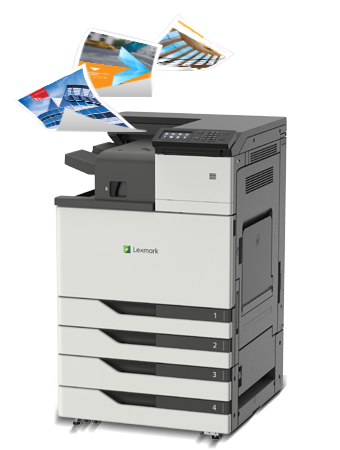
Multi-format output
Make a big impression with color output up to SRA3/12x18, handle A4/letter-size jobs with ease, and use the multipurpose feeder for everything down to small envelopes. Among the wide range of media types accepted are card stock, glossy stock, recycled paper, transparencies and labels.
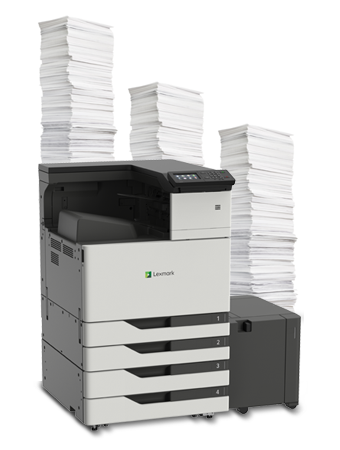
High-capacity production yields
Get input capacity up to 6,650 sheets with optional trays and up to 3,500 sheets of output with optional finisher, minimizing paper handling. Genuine Lexmark toner cartridges print up to 34,000 mono or color pages², while fusers and developer units go up to 720,000 and 600,000 pages⁴, respectively, for impressive uptime.
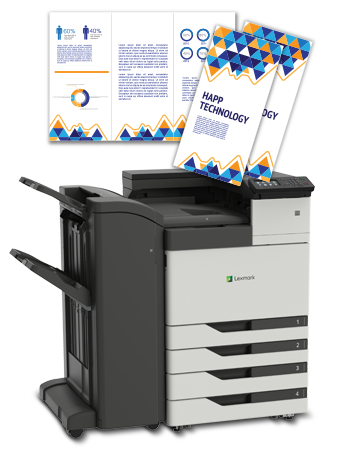
Finishing options
Expand your capabilities with finishing options that include multi-position stapling, hole punch, booklet, saddle stitch and tri-fold. The finisher raises output capacity to 3,500 sheets.
Smart features for professional performance
At your fingertips: Accurate color and included solutions, with industry-leading security built in.
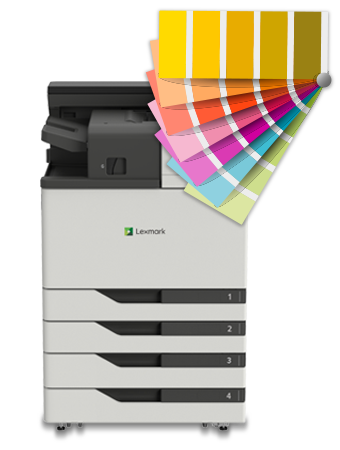
Professional color tools
Match your most critical colors and present your boldest ideas with a well-stocked color toolbox that includes PANTONE® calibration, embedded color sample pages and Lexmark Color Replacement for easy matching of spot and RGB colors.
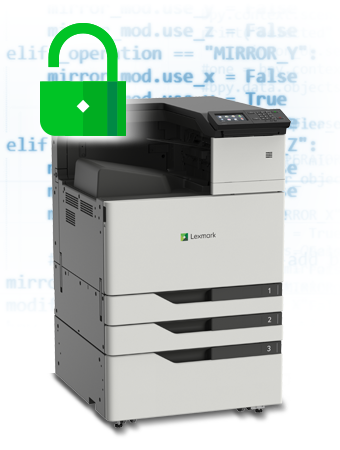
Full-spectrum security
Lexmark doesn’t treat security as an afterthought or optional feature, but as an integral design and engineering goal, embedded in all our products and services. And Lexmark’s industry-leading Full Spectrum Security features protect your documents, device, and network from unauthorized access.

Solutions
Enhance your user experience and productivity with included solution apps like “Forms and Favorites,” which lets you locate and print forms from network storage locations or content management applications right from the touch screen.
What model is best for you?
Choose from the features to find available models that target your needs.
| Model⁵ | Print / Copy Speed¹ | Input Capacity (standard/maximum) | Finishing Options |
|---|
¹Print and copy speeds measured in accordance with ISO/IEC 24734 and ISO/IEC 24735 respectively (ESAT). For more information see: lexmark.com/isospeeds
²Average continuous black or continuous composite color (CMY) declared yield in one-sided (simplex) mode up to this number of pages in accordance with ISO/IEC 19798. Actual yield will vary considerably based upon many factors. See www.lexmark.com/yields for more information.
³Product functions only with replacement cartridges designed for use in a specific geographical region. For more details, see lexmark.com/regions
⁴Actual Yield may vary based on other factors such as device speed, paper size and feed orientation, toner coverage, tray source, percentage of black-only printing and average print job complexity.
⁵This is a Class A device according to the FCC Rules and international electromagnetic emissions standards. This device is not intended for use in residential or domestic environments due to potential interference to radio communications.